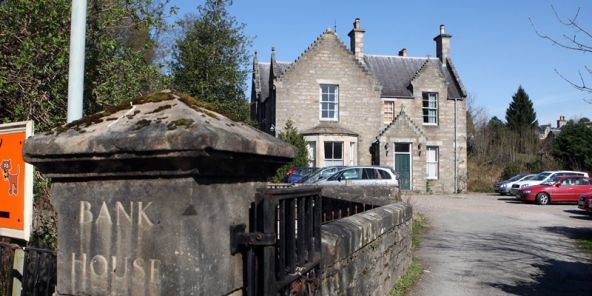Devastated Pitlochry residents have seen their hopes that councillors would throw out plans for a budget hotel in the centre of their town dashed.
But the determined campaign group has resolved to keep fighting against the scheme, which has finally received planning consent after three years.
Perth and Kinross Council’s development management committee voted to allow Upland Developments to knock down the 150-year-old Bank House and other buildings in the heart of the town’s conservation area.
In their place will be built a hotel, houses and new shop units.
The majority of the committee decided the potential economic benefits for Pitlochry and the wider community outweighed the dozens of objections from residents about the scheme.
Wednesday’s decision sparked fury on the public benches, with the vociferous objectors threatened with eviction from the building for their angry shouts.
Jim Tyrell, of Pitlochry Conservation Society, which was formed specifically to fight the proposal, said: ”I’m utterly and totally devastated by the whole thing. After almost three years fighting this, I didn’t expect to be standing here today with the centre of Pitlochry set to be despoiled by an inappropriate development.
”This has come about for no other reason than the wishes of a developer to gain at the expense of a community of 2,500 people. How can you preserve a conservation area by demolishing its only building of any merit?”
Pitlochry and Moulin Community Council also spoke out against the scheme and its chair, Andrew Holmes, said hopes now lie with Historic Scotland, which also came out in opposition this month.
The Scottish Government’s heritage watchdog could yet recommend the application be ”called in”, sparking a public inquiry.
Continued…
Mr Holmes said: ”The logic of the decision is not apparent to us. It flies in the face of the council’s own policies and the overwhelming local feeling.”
Another major concern for the objectors was the fact an economic appraisal of the project formed the basis for the officers’ recommendation to approve the plan, but had not been seen by the public or councillors.
Neil Simpson, an architecture expert brought in to Pitlochry Conservation Society, said: ”There was a development viability exercise which has not been seen by the councillors but was passed to Historic Scotland.
“They wrote a long letter to the council, noting there was no justification for the demolition and disagreeing with the council about the type of information required to satisfy them of that need.”
Another potential stumbling block is the lack of ownership rights on land surrounding the development site.
Pitlochry Estate Trust said it owns land on which four of five vital access bridges over the Moulin Burn would have to be built and is not willing to give it up.
Groups opposed to the scheme agree the area around Bank House should be redeveloped, but believe the building itself should be retained. They were backed at the meeting by some councillors.
Councillor Alan Livingstone said the ”natural habitat for this development is Cumbernauld or Glenrothes, not Pitlochry”, suggesting it could actually harm tourism.
Councillor Ian Campbell said it was massively out of step with what is needed in the town.
But they were voted down by others, including committee convener Councillor Tom Gray, who said the budget hotel would cater for clientele new to Pitlochry and significantly boost the local economy.
